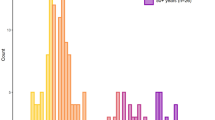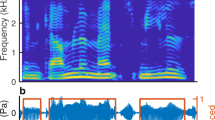Abstract
Children with a history of temporary conductive hearing loss (CHL) during early development may show long-term impairments in auditory processes that persist after restoration of normal audiometric hearing thresholds. Tones in noise provide a simplified paradigm for studying hearing in noise. Prior research has shown that adults with sensorineural hearing loss may alter their listening strategy to use single-channel energy cues for tone-in-noise (TIN) detection rather than rove-resistant envelope or spectral profile cues. Our objective was to determine the effect of early CHL on TIN detection in healthy children compared to controls. Children ages 4–7 years, with and without a history of CHL due to otitis media with effusion (OME) before age 3 years, participated in a two-alternative forced choice TIN detection task. Audiometric thresholds were normal at the time of testing. Thresholds for detection of a 1000 Hz tone were measured in fixed-level noise and in roving-level noise that made single-channel energy cues unreliable. Participants included 23 controls and 23 with a history of OME-related CHL. TIN thresholds decreased with increasing age across participants. Children in both groups showed similar TIN sensitivity and little or no threshold elevation in the roving-level condition compared to fixed-level tracks, consistent with use of rove-resistant cues. In contrast to older listeners with sensorineural hearing loss, there was no detectable change in TIN sensitivity with roving level for children with a history of OME-related CHL.


Similar content being viewed by others
References
Simpson SA, Thomas CL, van der Linden MK, Macmillan H, van der Wouden JC, Butler C (2007) Identification of children in the first four years of life for early treatment for otitis media with effusion. The Cochrane Database System Rev 1, CD004163. https://doi.org/10.1002/14651858.CD004163.pub2
Zielhuis GA, Rach GH, van den Bosch A, van den Broek P (1990) The prevalence of otitis media with effusion: A critical review of the literature. Clin Otolaryngol Allied Sci 15(3):283–288. https://doi.org/10.1111/j.1365-2273.1990.tb00787.x
Bluestone CD, Beery QC, Paradise JL (1973) Audiometry and tympanometry in relation to middle ear effusions in children. Laryngoscope 83(4):594–604. https://doi.org/10.1288/00005537-197304000-00015
Gravel JS, Wallace IF (2000) Effects of otitis media with effusion on hearing in the first 3 years of life. J Speech Lang Hear Res 43(3):631–644. https://doi.org/10.1044/jslhr.4303.631
Bennett KE, Haggard MP, Silva PA, Stewart IA (2001) Behaviour and developmental effects of otitis media with effusion into the teens. Arch Dis Child 85(2):91–95. https://doi.org/10.1136/adc.85.2.91
Lous J, Burton MJ, Felding JU, Ovesen T, Rovers MM, Williamson I (2005) Grommets (ventilation tubes) for hearing loss associated with otitis media with effusion in children. The Cochrane Database System Rev 1, CD001801. https://doi.org/10.1002/14651858.CD001801.pub2
McKenna Benoit M, Orlando M, Henry K, Allen P (2019) Amplitude Modulation Detection in Children with a History of Temporary Conductive Hearing Loss Remains Impaired for Years After Restoration of Normal Hearing. J Assoc Res Otolaryngol 20(1):89–98. https://doi.org/10.1007/s10162-018-00699-8
Paradise JL, Dollaghan CA, Campbell TF, Feldman HM, Bernard BS, Colborn DK, Rockette HE, Janosky JE, Pitcairn DL, Sabo DL, Kurs-Lasky M, Smith CG (2000) Language, speech sound production, and cognition in three-year-old children in relation to otitis media in their first three years of life. Pediatrics 105(5):1119–1130. https://doi.org/10.1542/peds.105.5.1119
Pillsbury HC, Grose JH, Hall JW (1991) Otitis media with effusion in children. Binaural hearing before and after corrective surgery. Otolaryngol Head Neck Surg 117(7), 718–723. https://doi.org/10.1001/archotol.1991.01870190030008
Roberts JE, Rosenfeld RM, Zeisel SA (2004) Otitis media and speech and language: A meta-analysis of prospective studies. Pediatrics 113(3 Pt 1):e238-248. https://doi.org/10.1542/peds.113.3.e238
Whitton JP, Polley DB (2011) Evaluating the perceptual and pathophysiological consequences of auditory deprivation in early postnatal life: a comparison of basic and clinical studies. JARO: J Assoc Res Otolaryngol 12(5), 535–547. https://doi.org/10.1007/s10162-011-0271-6
Winskel H (2006) The effects of an early history of otitis media on children’s language and literacy skill development. Br J Educ Psychol 76(Pt 4):727–744. https://doi.org/10.1348/000709905X68312
Caras ML, Sanes DH (2015) Sustained Perceptual Deficits from Transient Sensory Deprivation. J Neurosci 35(30):10831–10842. https://doi.org/10.1523/JNEUROSCI.0837-15.2015
Moore DR, Hine JE, Jiang ZD, Matsuda H, Parsons CH, King AJ (1999) Conductive hearing loss produces a reversible binaural hearing impairment. J Neurosci 19(19):8704–8711
Polley DB, Thompson JH, Guo W (2013) Brief hearing loss disrupts binaural integration during two early critical periods of auditory cortex development. Nat Commun 4:2547. https://doi.org/10.1038/ncomms3547
Werner L (2007) What do children hear? How auditory maturation affects speech perception. The ASHA Leader 12(4). https://doi.org/10.1044/leader.FTR1.12042007.6
Davidson SA, Gilkey RH, Colburn HS, Carney LH (2006) Binaural detection with narrowband and wideband reproducible noise maskers. III. Monaural and diotic detection and model results. J Acoust Soc Am 119(4), 2258–75. https://doi.org/10.1121/1.2177583. PMID: 16642840
Davidson SA, Gilkey RH, Colburn HS, Carney LH (2009) An evaluation of models for diotic and dichotic detection in reproducible noises. J Acoust Soc Am 126(4):1906–1925. https://doi.org/10.1121/1.3206583.PMID:19813804;PMCID:PMC2771055
Gilkey RH, Robinson DE (1986) Models of auditory masking: a molecular psychophysical approach. J Acoust Soc Am 79:1499–1510. https://doi.org/10.1121/1.393676
Mao J, Koch K, Doherty KA, Carney LH (2015) Cues for Diotic and Dichotic Detection of a 500-Hz Tone in Noise Vary with Hearing Loss. J Assoc Res Otolaryngol 16(4):507–521
Richards VM, Nekrich RD (1993) The incorporation of level and level-invariant cues for the detection of a tone added to noise. J Acoust Soc Am 94(5):2560–2574
Richards VM (2002) Varying feedback to evaluate detection strategies: The detection of a tone added to noise. J Assoc Res Otolaryngol 3(2):209–221
Kidd G, Mason CR, Brantley MA, Owen GA (1989) Roving-level tone-in-noise detection. J Acoust Soc Am 86(4):1310–1317. https://doi.org/10.1121/1.398745
Leong U-C, Schwarz DM, Henry KS, Carney LH (2020) Sensorineural Hearing Loss Diminishes Use of Temporal Envelope Cues: Evidence From Roving-Level Tone-in-Noise Detection. Ear Hear 41(4):1009–1019. https://doi.org/10.1097/AUD.0000000000000822
Grose JH, Hall JW 3rd, Dev MB (1997) MLD in children: Effects of signal and masker bandwidths. J Speech Lang Hear Res 40(4):955–959
Levitt H (1971) Transformed up-down methods in psychoacoustics. J Acoust Soc Am 49(2), Suppl 2:467+.
Bates D, Mächler M, Bolker B, Walker S (2015) Fitting linear mixed-effects models using lme4. ArXiv:1406.5823 [Stat]. http://arxiv.org/abs/1406.5823
Hawkins JE, Stevens SS (1950) The Masking of Pure Tones and of Speech by White Noise. J Acoust Soc Am 22(1):6–13. https://doi.org/10.1121/1.1906581
Allen P, Wightman F (1994) Psychometric functions for children’s detection of tones in noise. J Speech Hear Res 37(1):205–215. https://doi.org/10.1044/jshr.3701.205
Gravel JS, Roberts JE, Roush J, Grose J, Besing J, Burchinal M, Neebe E, Wallace IF, Zeisel S (2006) Early Otitis Media with Effusion, Hearing Loss, and Auditory Processes at School Age. Ear Hear 27(4):353–368. https://doi.org/10.1097/01.aud.0000224727.45342.e9
Schilder AG, Snik AF, Straatman H, van den Broek P (1994) The effect of otitis media with effusion at preschool age on some aspects of auditory perception at school age. Ear Hear 15(3):224–231. https://doi.org/10.1097/00003446-199406000-00003
Shetty HN, Koonoor V (2016) Sensory deprivation due to otitis media episodes in early childhood and its effect at later age: A psychoacoustic and speech perception measure. Int J Pediatr Otorhinolaryngol 90:181–187. https://doi.org/10.1016/j.ijporl.2016.09.022
Besing JM, Koehnke J (1995) A test of virtual auditory localization. Ear Hear 16(2):220–229
Hall JW, Grose JH (1994) The effect of conductive hearing loss on the masking-level difference: Insert versus standard earphones. J Acoust Soc Am 95(5 Pt 1):2652–2657. https://doi.org/10.1121/1.409834
Buss E, Hall JW, Grose JH (2006) Development and the role of internal noise in detection and discrimination thresholds with narrow band stimuli. J Acoust Soc Am 120(5 Pt 1):2777–2788. https://doi.org/10.1121/1.2354024
Jones PR, Moore DR, Amitay S (2015) Development of Auditory Selective Attention: Why Children Struggle to Hear in Noisy Environments. Dev Psychol 51(3):353–369. https://doi.org/10.1037/a0038570
Allen P, Jones R, Slaney P (1998) The role of level, spectral, and temporal cues in children’s detection of masked signals. J Acoust Soc Am 104:2997–3005
Henry KS, Kale S, Heinz MG (2016) Distorted tonotopic coding of temporal envelope and fine structure with noise-induced hearing loss. J Neurosci 36:2227–2237
Patterson RD, Nimmo-Smith I, Weber DL, Milroy R (1982) The deterioration of hearing with age: frequency selectivity, the critical ratio, the audiogram, and speech threshold. J Acoust Soc Am 72(6):1788–1803. https://doi.org/10.1121/1.388652. (PMID: 7153426)
Funding
The project described in this publication was supported by the University of Rochester CTSA award number UL1TR002001 from the National Center for Advancing Translational Sciences of the National Institutes of Health. The content is solely the responsibility of the authors and does not necessarily represent the official views of the National Institutes of Health.
Author information
Authors and Affiliations
Corresponding author
Ethics declarations
Conflict of Interests
The authors declare they have no conflicts of interest.
Additional information
Publisher's Note
Springer Nature remains neutral with regard to jurisdictional claims in published maps and institutional affiliations.
Rights and permissions
Springer Nature or its licensor (e.g. a society or other partner) holds exclusive rights to this article under a publishing agreement with the author(s) or other rightsholder(s); author self-archiving of the accepted manuscript version of this article is solely governed by the terms of such publishing agreement and applicable law.
About this article
Cite this article
McKenna Benoit, M., Henry, K.S., Orlando, M. et al. Tone in Noise Detection in Children with a History of Temporary Conductive Hearing Loss. JARO 23, 751–758 (2022). https://doi.org/10.1007/s10162-022-00871-1
Received:
Accepted:
Published:
Issue Date:
DOI: https://doi.org/10.1007/s10162-022-00871-1




